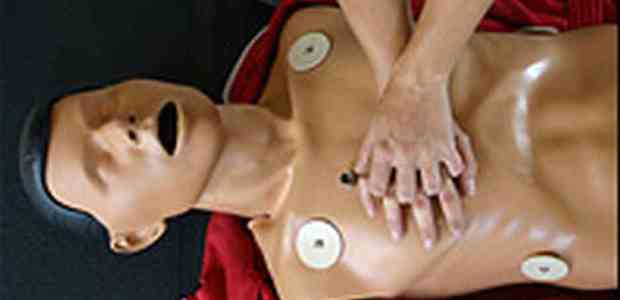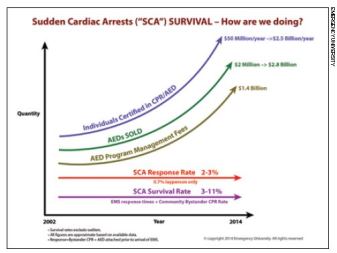
CPR/AED Training Isn't Enough: We Must Teach 'Response'
Failure to respond poses the real threat to SCA survival.
- By Odelia Braun
- Sep 01, 2014
It's 6:30 a.m. Two Federal Aviation Administration inspectors are enjoying a cup of coffee prior to beginning their duties at the American Airlines Training Center in Dallas when Inspector Ron Noe hears "someone snoring." He and Inspector Ray Trevino head over to investigate. They find a 50-year-old American Airlines pilot, Capt. Matt Taylor, on the ground, struggling to breathe. There are many people in the area, but they slowly move backward, forming a crowd of onlookers. The inspectors, who recently had completed their FAA Sudden Cardiac Arrest response training, step forward. They too, are apprehensive, having never seen a cardiac arrest victim, but they recognize this critical situation from their training and decide to follow the SCA response process they have learned. With hearts pounding, they assess Taylor, initiate CPR, grab the nearby AED, and attach the pads. The AED indicates a shock is advised, and they press the "Shock" button, then watch as the shock is delivered. Moments later, Taylor slowly opens his eyes.
 "It was amazing," Noe said afterward. "Within about a minute, I could see the life come back into his face." "What happened?" asked Taylor (shown here at left), bewildered, when he woke up minutes later. When EMS personnel arrived, he was able to climb onto the gurney himself.
"It was amazing," Noe said afterward. "Within about a minute, I could see the life come back into his face." "What happened?" asked Taylor (shown here at left), bewildered, when he woke up minutes later. When EMS personnel arrived, he was able to climb onto the gurney himself.
At the time of his cardiac arrest in 2012, Taylor's wife was six months pregnant. After the birth of his daughter, he told us, "Had it not been for courageous actions of the FAA inspectors, my daughter would not have known what it was like to be held and loved by her father."
FAA's SCA Response Program
Each year, between 40 million and 50 million people enroll in CPR/AED classes at a cost of more than $2.5 billion annually. Despite the growing number of available trained individuals, only 2 percent of cardiac arrest victims receive an effective response, immediate CPR, and the attachment of an AED. With 330,000 Americans experiencing out-of-hospital SCAs each year, it's essential that we pay for training that results in individuals who respond and, therefore, saves lives.
 The FAA has incorporated SCA response training into its nationwide Public Access Defibrillation Program. In addition to teaching CPR and AED skills, an SCA response class based on behavioral science principles was developed to overcome cultural and emotional barriers and establish a team-based emergency response structure based on each facility's emergency response plan. The FAA SCA response program targets 45,000 employees across 183 locations nationwide. During the past five years, the FAA's SCA response rate remains 100 percent--in fortunate contrast to the national average of 2 percent.
The FAA has incorporated SCA response training into its nationwide Public Access Defibrillation Program. In addition to teaching CPR and AED skills, an SCA response class based on behavioral science principles was developed to overcome cultural and emotional barriers and establish a team-based emergency response structure based on each facility's emergency response plan. The FAA SCA response program targets 45,000 employees across 183 locations nationwide. During the past five years, the FAA's SCA response rate remains 100 percent--in fortunate contrast to the national average of 2 percent.
One American collapses of an SCA every two minutes, and only half of them have any prior history of cardiovascular disease. (Taylor was known for his commitment to fitness and had no prior cardiac history.) Fifty percent have no warning at all. The vast majority of cardiac arrests take place at work, in public places, or in the home. While EMS systems have evolved to bring trained medical professionals rapidly to the scene of a medical emergency, the optimal window for medical intervention of an SCA is most often too narrow to get the necessary equipment and skills to the victim's side in time to save his or her life.
The probability of surviving an out-of-hospital cardiac arrest is at least doubled for victims who receive bystander CPR. SCA victims who receive bystander CPR and the benefit of a shock from an AED within four minutes quadruple their chance of survival. Sadly, victims receive the benefit of bystander CPR only 7 to 28 percent of the time. They receive the combined benefit of bystander CPR and an AED a dismal 2 to 3 percent of the time. This means only two out of every 100 cardiac arrest victims receive bystander CPR and have an AED attached prior to the arrival of EMS.
If millions of people are trained each year, why haven't response rates increased during the past decade?
Society Promotes CPR/AED Training Because We Want to Save Lives
Because cardiovascular disease takes more lives than any other disease or injury in the United States, we promote CPR/AED training because we want to save more lives. We want to increase the number of survivors. We want trained individuals to respond to sudden cardiac arrest victims, perform CPR, and attach and operate an AED.
Obtaining CPR/AED certification has become the "goal" and not a "means" to the goal of saving lives. Since some companies require a CPR/AED certification card, simply obtaining a CPR/AED certification card has become the goal for both the employee and the employer. But clearly, just obtaining CPR/AED certification does not result in saving more lives.
Traditional classes teach CPR and AED as isolated skill sets, but research demonstrates that laypersons with CPR/AED skills training alone do not respond. An instructor's best intentions during CPR/AED classes may actually increase the reluctance of trainees to respond. For example, concerns about what could go wrong, rarely occurring complications, and performing skills perfectly can erode confidence and increase apprehension of the infrequent responder.
Teaching SCA Response Skills Will Save Lives
Response skills must prepare trainees for what they're actually required to do when responding to a cardiac emergency. By incorporating behavioral science principles, cultural barriers regarding touching or undressing others and emotional barriers about death and performing in public can be overcome.
Compressing manikins in a classroom is a far cry from the emotionally daunting event of finding the collapsed body of a co-worker with whom you may have had a cup of coffee with that very morning. Few trainees are afraid to touch a manikin or remove its shirt. But that is not a realistic simulation of assessing a collapsed co-worker or removing his clothes in public, so the skills do not translate into response.
Training manikins don't breathe, their chests don't move, they never have a pulse, and their skin color never changes. Therefore, trainees must be taught how to assess actual people–themselves and their classmates. It's also important that instructors utilize equipment most closely resembling the AED equipment the trainee will use, not generic black boxes. Creating visual clues and familiar audio prompts will create confidence during an emergency.
The words chosen to teach emergency response assessment skills must be sufficiently clear that an infrequent responder can make an immediate and confident decision even with limited experience. If the trainee cannot make a confident decision, he won't make a decision at all. It is not reasonable to expect a first-time responder to engage in complex analysis. For example, traditional classes teach that CPR should be provided when the victim is "unresponsive." However, what does "unresponsive" mean to a layperson? Instead, we must use words that the trainee already has experience with. For instance, the trainee has experience in determining whether a person is making sounds or moving. Therefore, CPR should be initiated "if the victim is not making any sounds and not moving."
SCA response training must define the organizational or "team" structure. For example, the designation of roles and the responsibilities of the leader and team members must be defined prior to the emergency. SCA response should be taught using realistic simulations that evaluate the trainee's learning comprehension and its application. Recommended as the most effective training methodology for emergency medical skills, scenario-based training enables trainees to practice in a simulated setting with limited risk until they become comfortable with the entire response sequence.
We must integrate and evaluate non-technical skills, such as leadership, communication, teamwork, and response skills, not just isolated CPR/AED skills. Since incorporating behavioral-based training, the FAA has realized a 100 percent SCA response rate. In fact, after the incident with Taylor, FAA Manager of Employee Safety and Health Services Dr. Tom Holloway commented, "We are grateful to the FAA administrator and his executive team for their support and to the thousands of FAA volunteers who have invested their time in this vital program to give their co-workers a second chance at life."
The physical skills of performing CPR and operating an AED are relatively easy to learn. Failure to respond poses the real threat to SCA survival. Considering that 40-50 million people are CPR/AED certified each year, the stagnant response rate of 2 percent is unacceptable. By recognizing that most current AED/CPR training programs do not save lives as intended and by benchmarking programs with high response rates, we can evaluate, design, and provide training solutions to increase response rates, which in turn increases survival rates.
Responding to SCA: What Trainees Need to Know
- Emergency assessment skills
- Familiarity with the facility’s emergency response plan
- Mechanism of activating on-site emergency response system
- Location of operational AEDs
- Mechanism of notifying on-site trained responders
- Practice response procedures from discovery of victim through transfer to EMS
This article originally appeared in the September 2014 issue of Occupational Health & Safety.